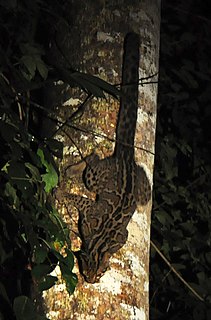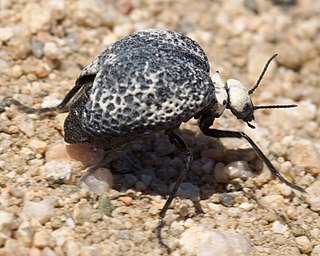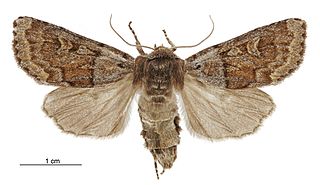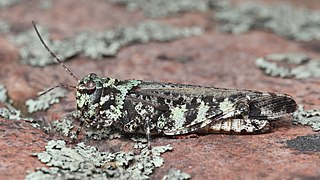
The marbled cat is a small wild cat native from the eastern Himalayas to Southeast Asia, where it inhabits forests up to 2,500 m (8,200 ft) altitude. As it is present in a large range, it has been listed as Near Threatened on the IUCN Red List since 2015.

Nannophrys is a genus of frogs endemic to Sri Lanka. It used to be placed in the large frog family Ranidae but a phylogenetic study was undertaken using DNA sequences and it is now included in the family Dicroglossidae. They are sometimes known under the common name streamlined frogs.

The Western Pond Turtle, also known commonly as the Pacific pond turtle is a species of small to medium-sized turtle in the family Emydidae. The species is endemic to the western coast of the United States and Mexico, ranging from western Washington state to northern Baja California. It was formerly found in Canada, but in May 2002, the Canadian Species at Risk Act listed the Pacific pond turtle as being extirpated.
Indigofera marmorata is a species of legume in the family Fabaceae. It is found only in Yemen. Its natural habitats are subtropical or tropical dry forests and subtropical or tropical dry shrubland.
Nanohyla marmorata is a species of frog in the family Microhylidae. It is found in Laos and Vietnam. It is not considered threatened by the IUCN.

Scaphiophryne marmorata is a species of frog in the family Microhylidae. It is commonly known as the green burrowing frog and the marbled rain frog. It is endemic to Madagascar. It is classified as "Vulnerable" by the IUCN as it is threatened by habitat loss.

Nannophrys marmorata, commonly known as Kirtisinghe's rock frog or marbled streamlined frog, is a species of frog endemic to Sri Lanka. It used to be placed in the large frog family Ranidae but a phylogenetic study was undertaken using DNA sequences and it is now included in the family Dicroglossidae. Its natural habitats are tropical moist lowland forests, moist montane forests, rivers and streams. It is threatened by habitat loss.

The marbled electric ray is a species of electric ray in the family Torpedinidae found in the coastal waters of the eastern Atlantic Ocean from the North Sea to South Africa. This benthic fish inhabits rocky reefs, seagrass beds, and sandy and muddy flats in shallow to moderately deep waters. It can survive in environments with very little dissolved oxygen, such as tidal pools. The marbled electric ray has a nearly circular pectoral fin disc and a muscular tail that bears two dorsal fins of nearly equal size and a large caudal fin. It can be identified by the long, finger-like projections on the rims of its spiracles, as well as by its dark brown mottled color pattern, though some individuals are plain-colored. Males and females typically reach 36–38 cm (14–15 in) and 55–61 cm (22–24 in) long respectively.
Oedodera marmorata, also known as the marbled gecko, is a species of gecko endemic to New Caledonia.
Isoperla marmorata, the red stripetail, is a species of green-winged stonefly in the family Perlodidae. It is found in North America.

Corythucha marmorata, the chrysanthemum lace bug, is a species of lace bug in the family Tingidae. It is found in Central America and North America.
Enoplognatha marmorata, the marbled cobweb spider, is a species of cobweb spider in the family Theridiidae. It is found in North America.
Glyptoscelimorpha marmorata is a species of false jewel beetle in the family Schizopodidae. It is found in North America.
Phodaga alticeps is a species of blister beetle in the family Meloidae. It is found in North America.

Cysteodemus armatus, the inflated blister beetle, is a species of blister beetle in the family Meloidae. It is found in Central America and North America. The wing covers, which are mostly glabrous, are inflated to the point of almost covering part of the thorax. They are black, densely spotted with white. The elytra are fused along the middle, meaning that the beetle cannot fly.
Zavreliella marmorata is a species of midge in the family Chironomidae. It is found in Europe.

Stamnodes marmorata is a species of geometrid moth in the family Geometridae. It is found in North America.
Taedia marmorata is a species of plant bug in the family Miridae. It is found in Central America and North America.

Ichneutica marmorata is a moth of the family Noctuidae. This species is endemic to New Zealand can can be found in the North Island at the Tongariro National Park and at Puketitiri near the Kaweka Range. In the South Island it is widespread. It prefers alpine to subalpine habitat but occurs down to sea level altitudes in more southern locations. Adults are on the wing from late October to February. Larvae of this species may use tussock grasses in the genus Chionochloa as their host and they have been reared on Festuca novae-zelandiae.

Spharagemon marmorata, the marbled grasshopper, is a species of band-winged grasshopper in the family Acrididae. It is found in eastern North America.










